Hubspot is a comprehensive platform with a wealth of tools and features. However, many of these features can be overwhelming and downright unnecessary for many marketing managers and content agencies. And when the costs are proportionally high for what you actually use, it makes sense to explore HubSpot alternatives.
So whether you’re looking for content marketing tools for your in-house team or social media management tools for agencies, let’s look at some options that can meet your team’s specific needs (with fewer onboarding headaches and less breaking the bank).
Why you should look for an alternative to HubSpot
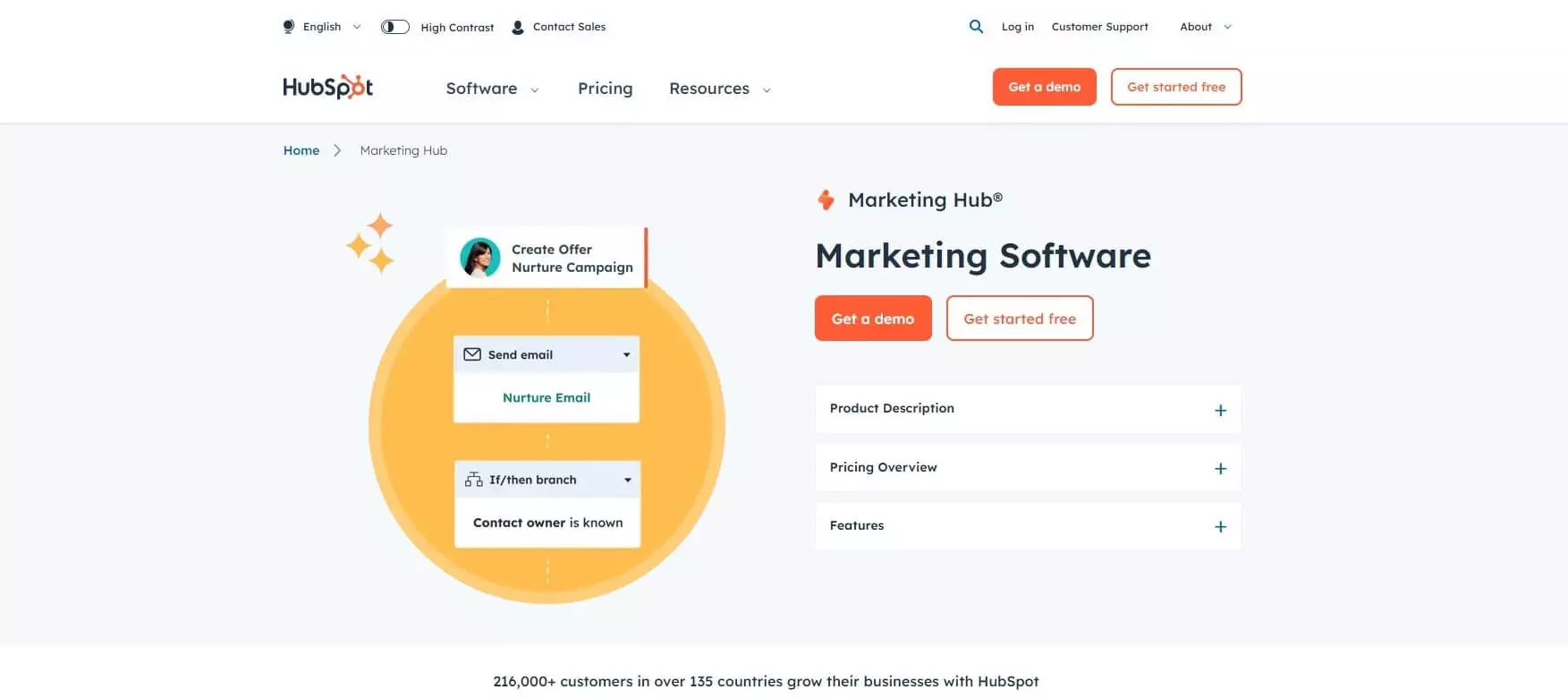

HubSpot organizes its features into six hubs: marketing, sales, service, content, operations, and commerce. Marketing managers and agencies often look for alternatives to HubSpot, especially because content collaboration features are stronger on other platforms. Other top reasons include improved control over client workflows, smoother integrations with social media, and, of course, better value for that monthly subscription.
Let’s see how Hubspot measures up when it comes to three of the most important factors in a content marketing or social media tool.
Planning
Planning in HubSpot happens via the marketing calendar, as part of the Marketing Hub. The calendar is where you plan all of your campaigns, as well as tactical initiatives and smaller campaign tasks. Each of these is called an event, and you can use various calendar views to sort and filter as you please.
The marketing calendar is only available with the Professional and Enterprise tiers, which can get costly. The Professional tier, for example, starts at $890/month for three seats.
Collaboration
A lot of HubSpot’s collaboration features live in the collaboration sidebar (also only available with the Professional or Enterprise plans). From here, you can comment on assets, review tasks, and bring your team together around the marketing calendar. However, there are several limitations to consider.
The ability to leave comments depends on being assigned a paid seat and on the format you’re working with. Forms, emails, and specific campaign elements are included, while blogs and social media posts are not. There’s also no option for adding annotations or suggestions straight to the text.
Approvals
Approvals also happen in the collaboration sidebar. The type of content you can approve (or assign others to approve) depends on your plan. For example, you’ll need the Enterprise tier to do email approvals and “Draft only” permissions for social posts.
Social media publishing is limited to Instagram, Facebook, LinkedIn, and Twitter.
HubSpot has no native multi-level approval workflow. So if you need multiple stakeholders to approve something, it’s going to involve workarounds.
Pricing: Tiers and prices differ from hub to hub, but for marketing, plans start at €15/user/mo, billed yearly (and they include a 14-day free trial). The Free Tools tier stays free forever and includes access to essential features from all six hubs.
Here’s why marketers should consider a marketing automation alternative to HubSpot
- Cost and feature set: Some users upgrade in order to gain access to certain features, but they also end up paying for plenty they don’t use.
- Complexity: Making true use of everything HubSpot has to offer requires energy and time, in amounts not everyone is likely to have.
- Reporting: This feature is very, very limited with the free plan and the reporting add-on is $200/month.
1. Planable – best for content collaboration and approvals
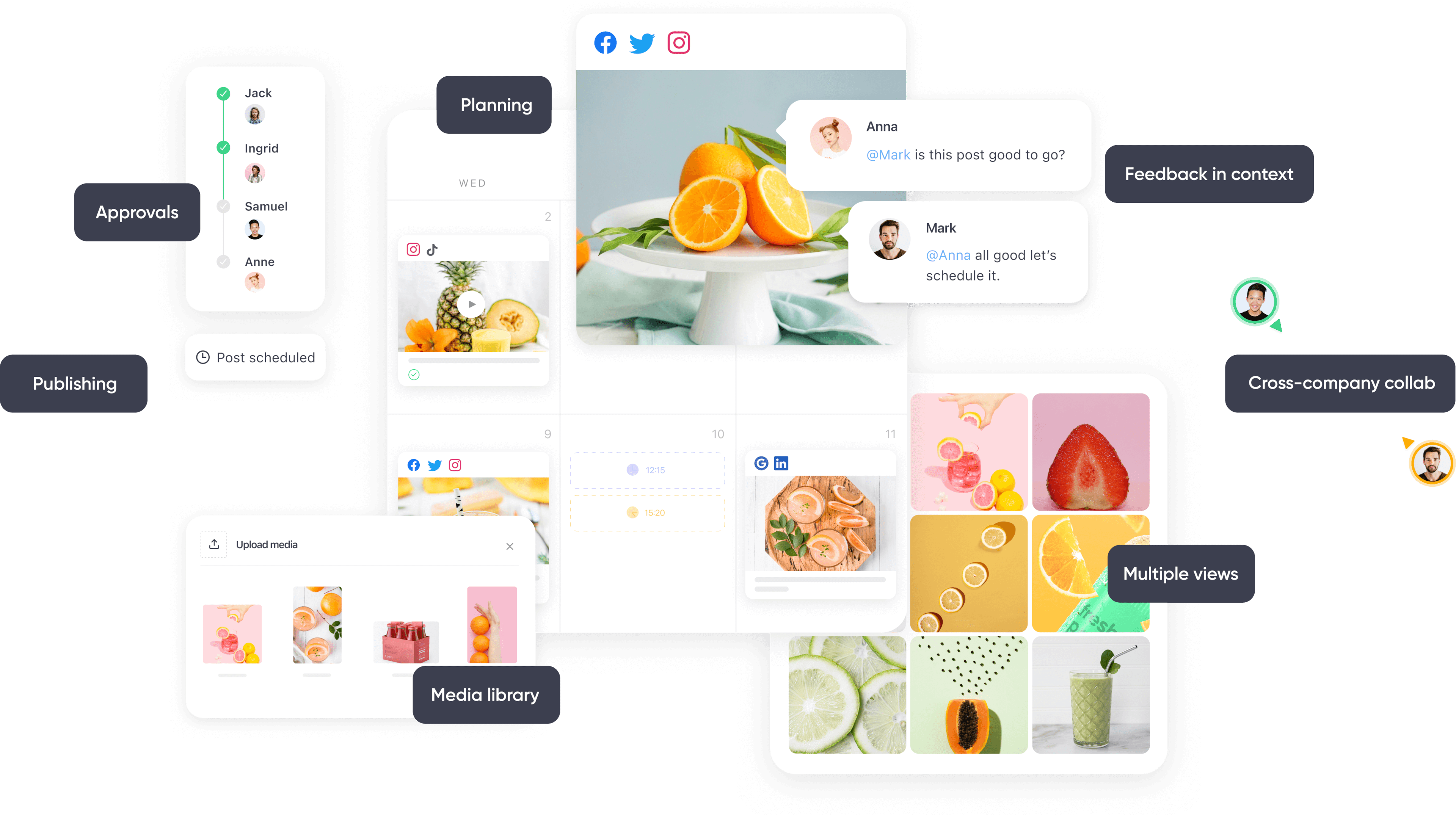

Planable’s social media management features for collaborative content creation
Planable is a social media and marketing automation platform that helps teams plan, execute, and measure marketing strategies from a single streamlined dashboard. You can schedule posts for Instagram, Threads, Facebook, Twitter, YouTube, LinkedIn, Google My Business, TikTok, and Pinterest. But one of the best parts is Universal Content, the feature bundle that gathers all your other content in the same place (be it ads, blogs, press releases, or email marketing).
Planable is the best among HubSpot alternatives because it was created for collaboration. You can add real-time comments, annotations, and clear text suggestions in context. Approvals are streamlined too: you customize multi-level approval layers and easily set custom roles or permissions. It’s a breeze to get clients in the loop or build mock-ups, but you can also keep posts and comments internal until everything is ready.
Planning
The calendar is your home base. You schedule and reschedule with a simple drag-and-drop, while labels, custom views, and color-coded labels sort everything to your liking. Each workspace has its own media library and preferred posting times.
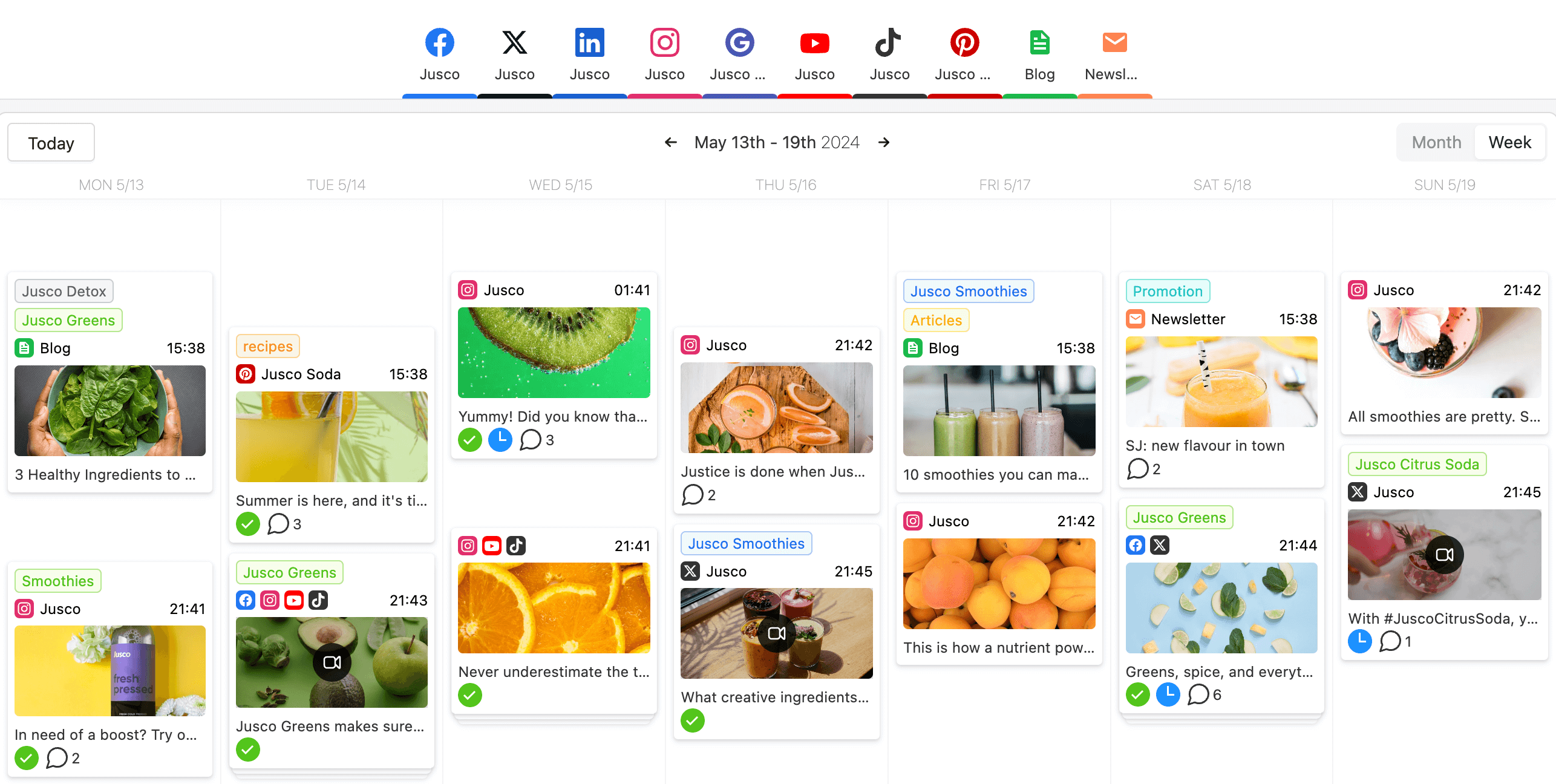

Content calendar in Planable
If inbound marketing is your focus, look no further than Universal Content. You can plan everything in the same place, always with rich text and the option to embed images, GIFs, tweets, and YouTube videos.
Collaboration
Real-time comments are a super-useful feature, especially since accurate previews are always on hand. You never have to chase down feedback via email again. Invite teams to add suggestions and annotations (GIFs and attachments included!), but also keep everything organized by brand or client in dedicated workspaces.
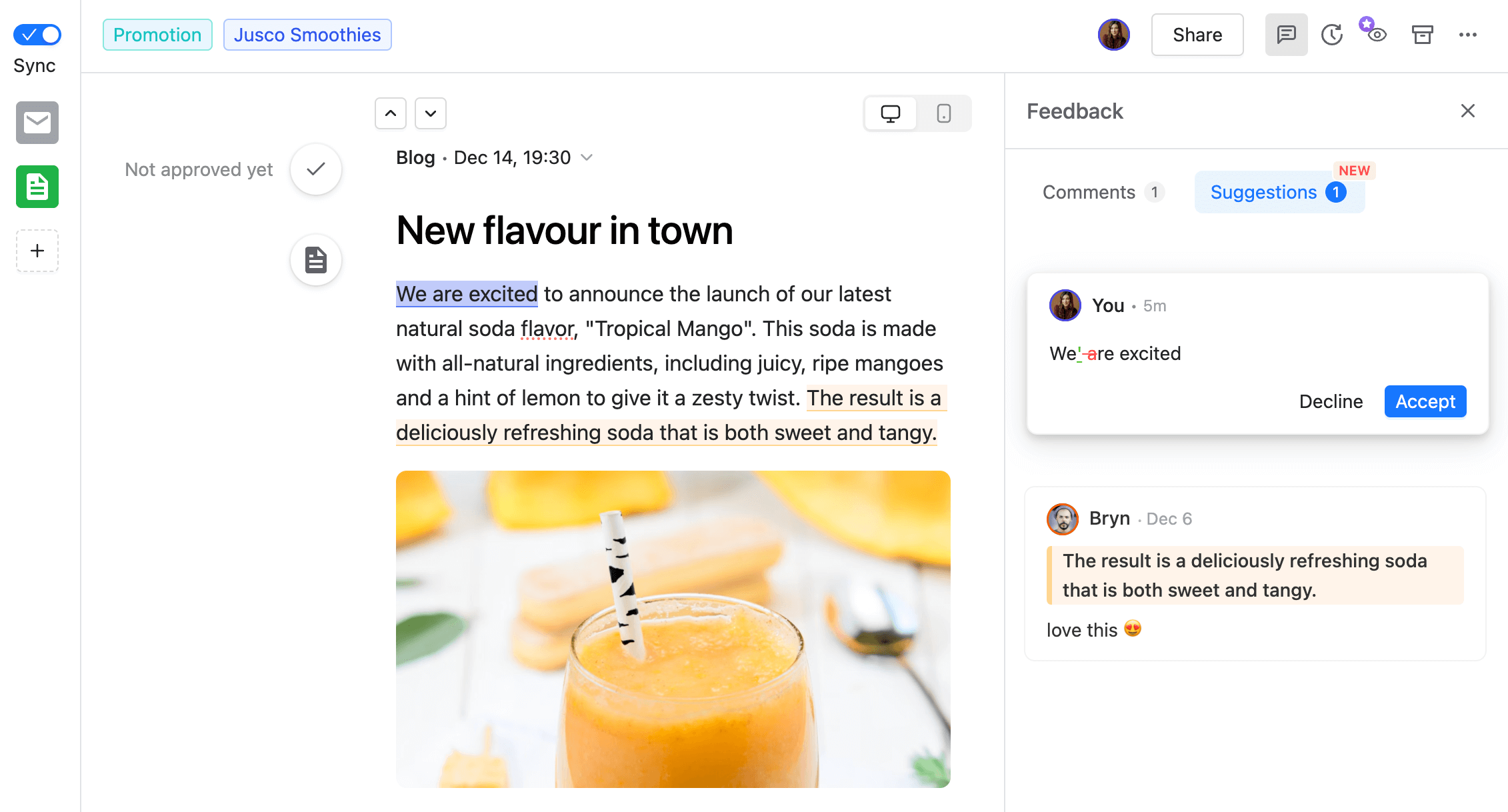

Collaboration on a blog post in Planable
Feedback gets even smoother with the post activity history plus the option to revert changes as needed. The mobile app lets you take everything on the road, and its notifications (or emails) efficiently ping everyone who’s contributing.
Approvals
You get to define exactly what approval workflows look like for each workspace: none, optional, mandatory, or multi-level.
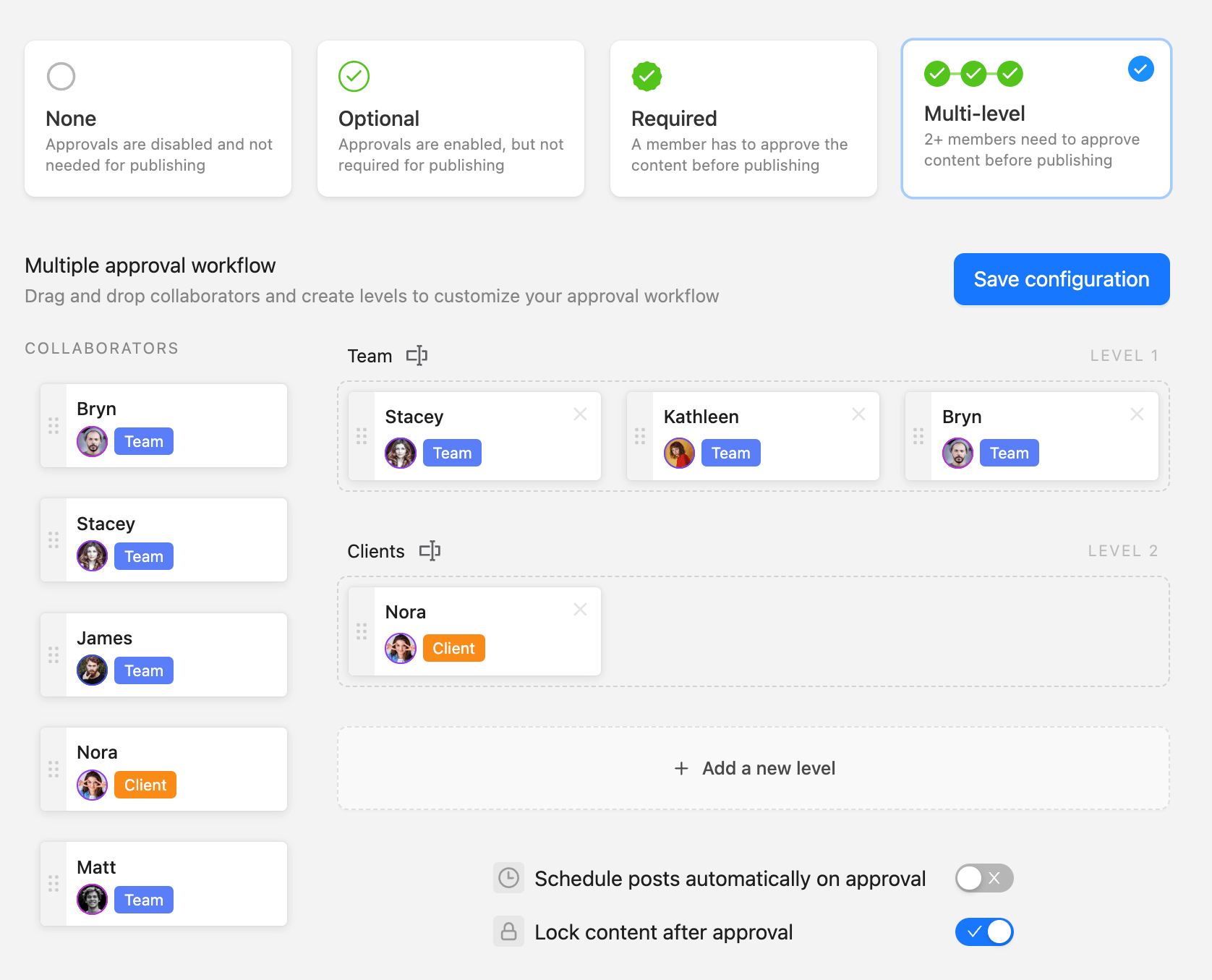

Multi-level approval flow in Planable
Mock-up pages match each social media platform, and there’s the option to automatically schedule posts after approval. Every comment and suggestion becomes its own little task. You easily mark feedback as resolved and that’s it! Tiny task, done.
Pricing: You can schedule 50 posts on the free plan, which has access to most features. Tiers start at $33/user/mo, billed yearly.
Drawbacks: You can’t publish to websites since the tool doesn’t yet have any direct integrations with CMS platforms and there’s no social listening.
Planable vs HubSpot
- HubSpot places features that are crucial for social and content teams (marketing calendar, collaboration sidebar, blog comments) behind the hefty paywall involved with upper tiers. With Planable, all these features are included from the free plan upwards.
- Planable makes collaboration easy for any type of written content. Comments, annotations, and suggestions are available regardless of format. Permissions for them can be assigned to anyone (stakeholder, client, external collaborator), without the need for a paid seat.
- Approval is a critical stage of the content workflow and often involves at least one external contributor. Hubspot’s pay-per-seat model isn’t ideal here. Planable’s approvals are easy to set up and customize. The multi-level version gets you the green light from multiple people with no fuss.
Takeaway: Planable doesn’t just bring great marketing automation capabilities. It streamlines your agency workflow by organizing all your content, for and beyond the socials, in a calendar that’s built for smooth collaboration and approval. If your growing agency or marketing department values using an intuitive tool that adds only the good features (and by “adds“, I don’t mean “exclusively to an expensive plan“), then you can’t go wrong with Planable.
2. Wrike – best for marketing automation with a CRM system


Wrike is a project management tool that helps sales and marketing teams set up automated workflows and measure their impact, all with simple but mighty CRM software in the mix. It also includes campaign planning tools, asset production features, and detailed analytics that integrate with Google Ads and Facebook Ads.
Key features
- Intuitive workflow automation for everything from work requests to final approvals
- Task, project, and resource management tools geared toward increasing productivity while avoiding burnout
- Integrations with more than 400 of the most frequently-used apps, plus the option to go for custom integrations with thousands more
Pricing: There’s a free plan with a limit of 200 active tasks and a 14-day free trial for all the other tiers, which start at $9.80/user/mo, billed yearly.
Drawbacks: Setting up Wrike isn’t exactly intuitive for new users, plus the UI can make the wealth of tools and customization options feel overwhelming.
3. Sprout Social – best for influencer marketing
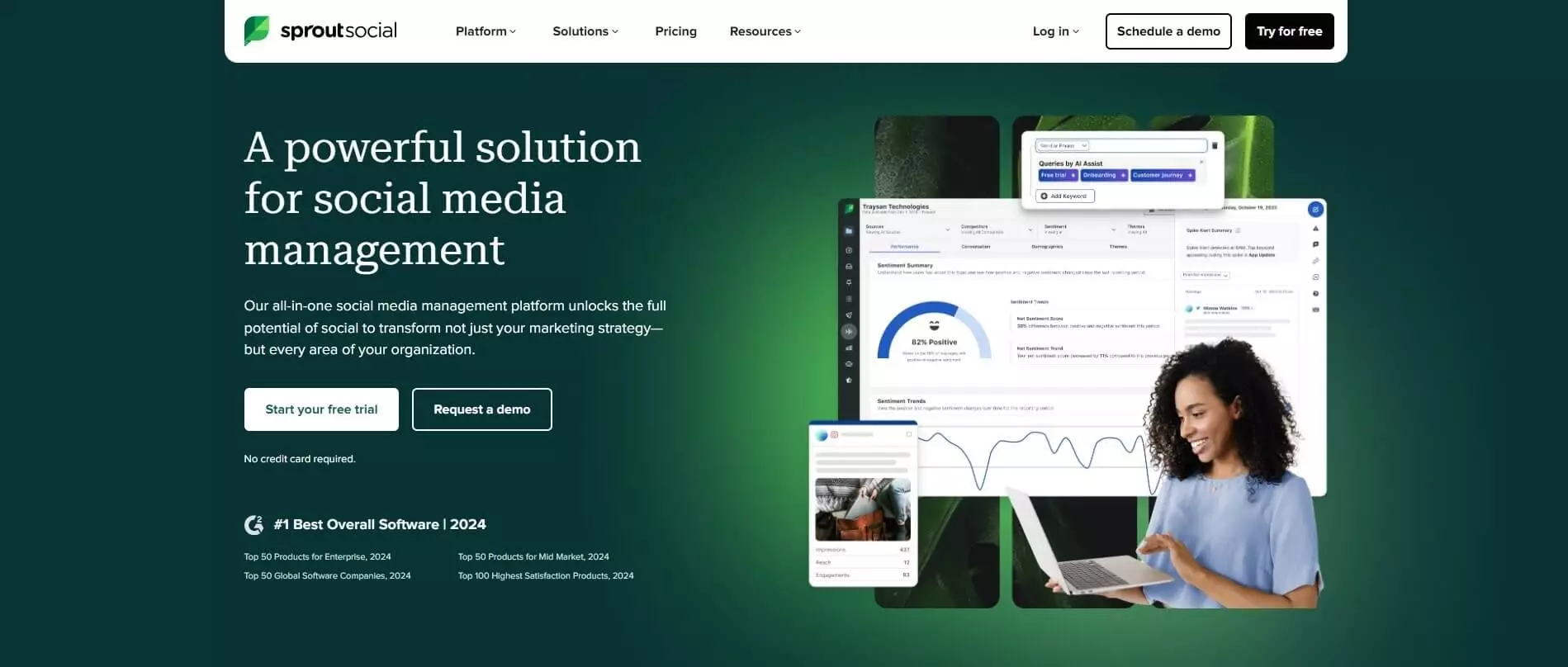

Sprout Social is a social media management platform that focuses on engagement, social listening, and helping marketing teams leverage their relationships with influencers. It’s got integrated customer relationship management tools for the socials, all with a focus on providing context info that helps give people a positive brand experience.
Key features
- Social commerce solutions that integrate product and customer info into social workflows
- Engagement tools that help users prioritize messages via sentiment detection (crisis notifications included)
- A strong social listening bundle with sentiment research, influencer recognition, trend identification, and crisis management
Pricing: Tiers start at $199/user/mo billed yearly, and three of four plans come with a 30-day free trial.
Drawbacks: Some users say it’s difficult to scale up, and that there are some scheduling issues, especially for LinkedIn.
4. Planoly – best for creating and scheduling visual content
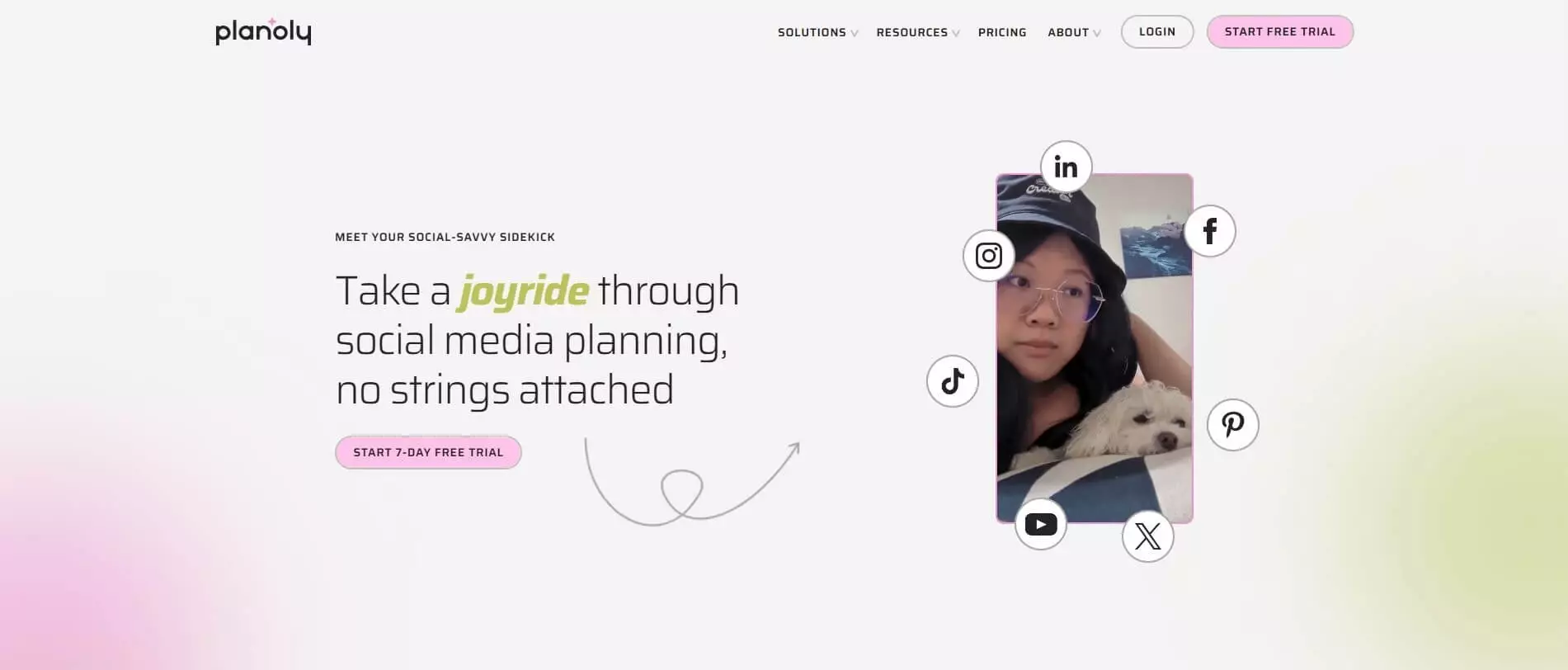

Planoly is a social media scheduler that was developed for visual-forward platforms. It excels at planning for Instagram and Pinterest, but also covers TikTok, YouTube, Facebook, LinkedIn, and Twitter. Marketing and sales teams can benefit from using Planoly especially if their focus is on Instagram marketing.
Key features
- Linkit, a powerful link-in-bio tool for monetizing Instagram accounts via a shoppable gallery
- Social media scheduling for seven platforms, with simple repurposing and strong hashtag management
- Creator tools including content editing, a Canva integration, plus plenty of templates and post ideas
Pricing: Plans start at $14/mo, billed annually, and all three have a 7-day free trial.
Drawbacks: Planoly doesn’t support Google My Business, and users report glitches with scheduled posts (especially photos, videos, and carousels). It also lacks the marketing automation features you’ll find on other platforms.
5. HeyOrca – best for basic social media scheduling
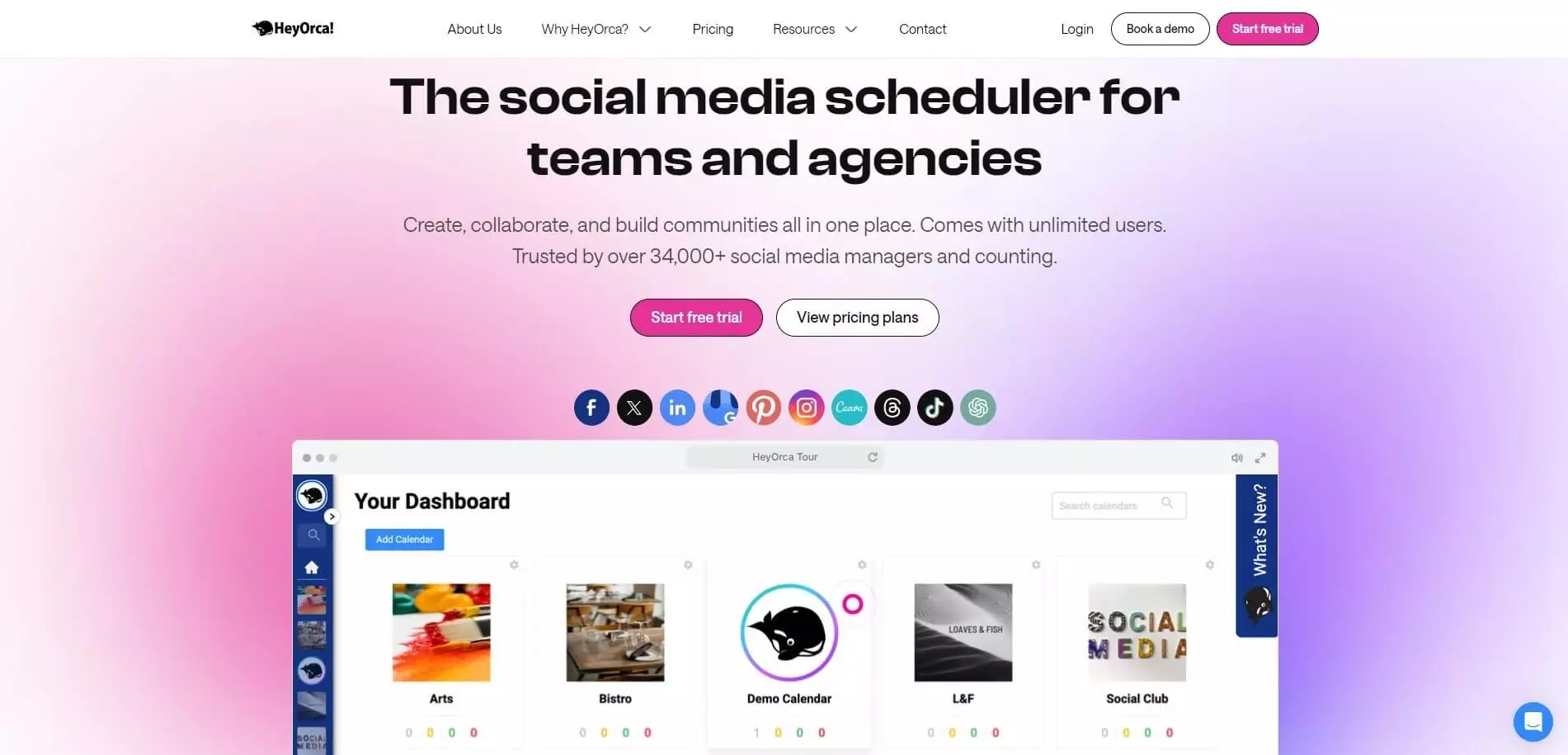

HeyOrca is a social media scheduler that was purpose-built for social marketing agencies but also caters to non-profits, faith-based organizations, and small businesses in general. When you send clients a link to the calendar, it lets you customize the branding for an extra-professional look. Plus, there’s an intuitive interface and reliable customer support.
Key features
- Community management via a social inbox that lets you filter comments by account, sort them, and save the stock replies you use most
- Scheduling for social media that covers Facebook, Instagram, Twitter, LinkedIn, Google My Business, and Pinterest
- Analytics that stay client-friendly, with the option to automate scheduled reports or grant direct access to the dashboard (complete with custom user permissions)
Pricing: All three plans have a 14-day free trial. After that, tiers start at $29/calendar/mo, billed yearly. Users are unlimited, but plans require a minimum purchase of five calendars.
Drawbacks: Unfortunately, HeyOrca is not a super-versatile tool beyond the calendar. If you also need social listening or ways to manage other types of content, it’s probably not your best bet.
6. ActiveCampaign – best CRM software with email automation
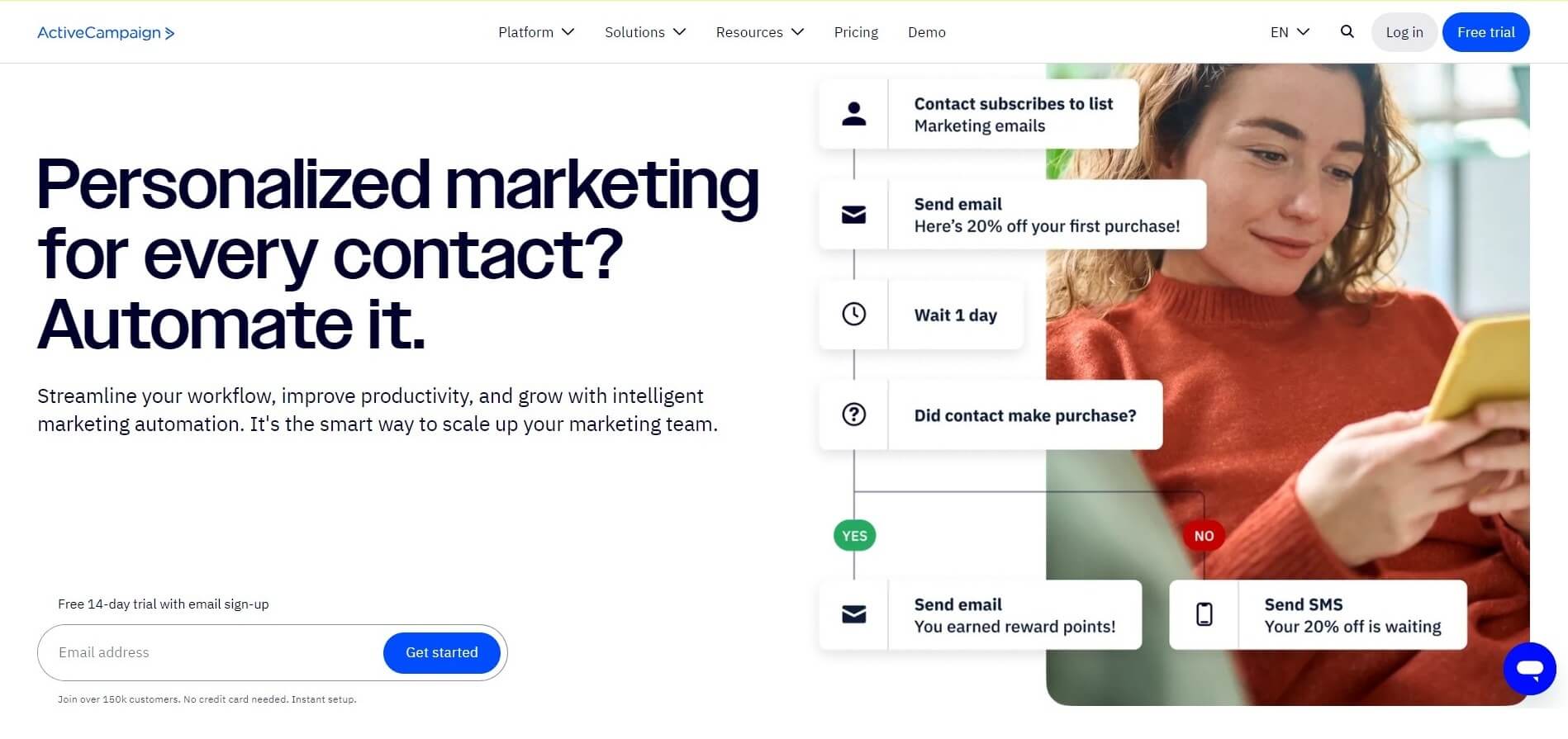

ActiveCampaign does email and marketing automation really well. It organizes its suites of tools by size of business (solopreneurs, small and medium businesses, enterprises) and by industry (agencies, eCommerce businesses, education, SaaS, healthcare, travel, non-profit, etc.).
The team behind ActiveCampaign is focused on delivering marketing automation software that has similar features to HubSpot but at a fraction of the cost. Extra automation features you won’t find on HubSpot include advanced segmentation, unlimited automations, split testing, and the ability to see everything on an automation map. All in all, a great HubSpot CRM alternative.
Key features
- Marketing automation with split and conditional actions, site tracking, and predictive sending
- Contact management with data-driven segmentation, lead management, and personalized dynamic content
- CRM that covers sales pipelines, task management, and much more
Pricing: You can enjoy the free trial for 14 days, then plans start at $15/mo, billed yearly, with 50% off for the first three months.
Drawbacks: Free customer support over the phone is not available with the lower tiers, and some users report waiting weeks to hear back when submitting a ticket via email. Also, automation can sometimes get glitchy.
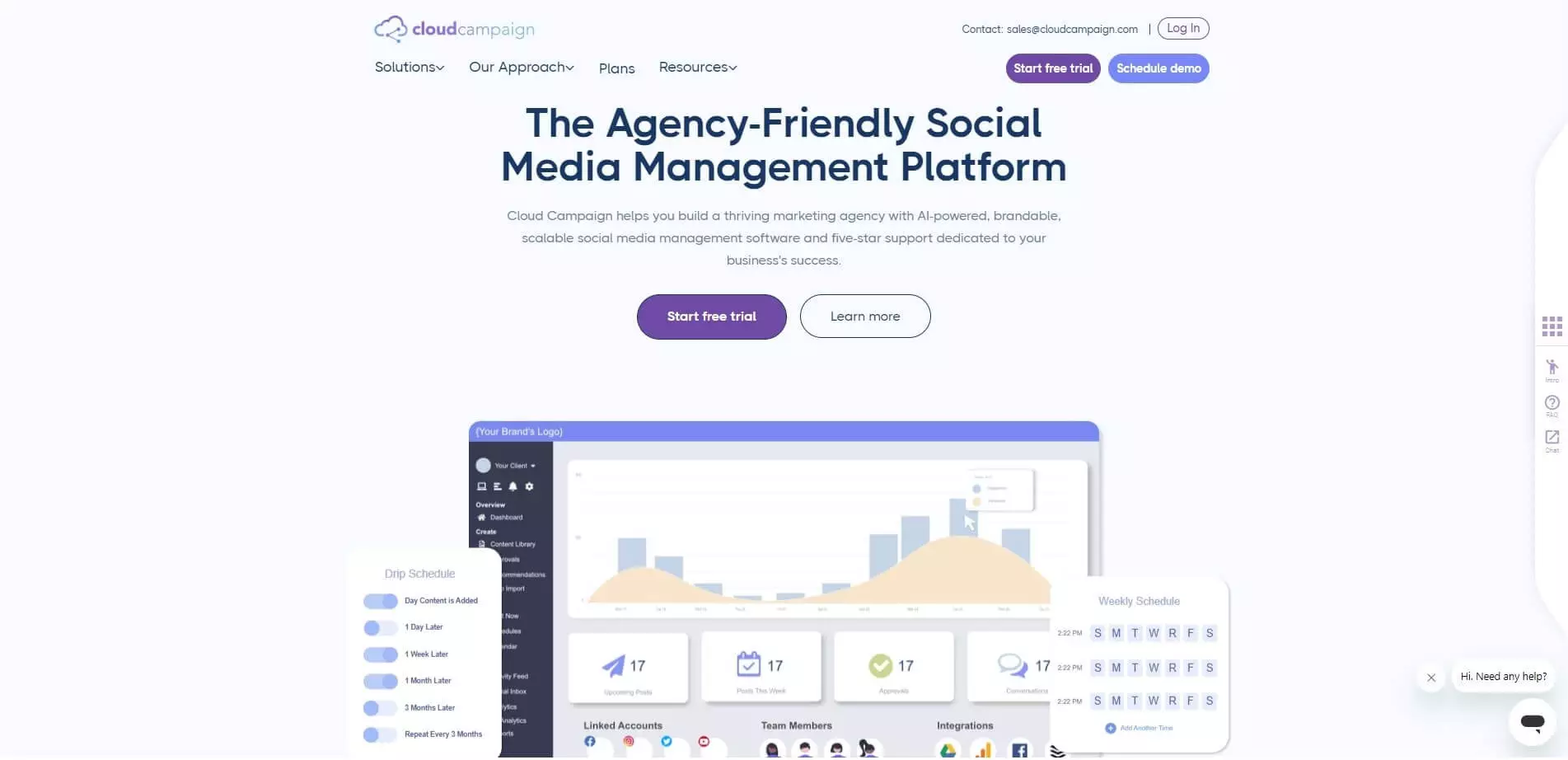

Cloud Campaign is a social media marketing platform that allows agencies to deliver white-labeled solutions to their clients. Two of the three available pricing plans include the option to create a branded social media service that nourishes an agency’s ability to scale efficiently.
This tool also has enterprise-level hosting that lets you embed its social capabilities into larger SaaS products. Beyond marketing agencies and large companies, it’s got plans and feature suites tailored to freelancers, consultants, and small creative studios.
Key features
- White-labeling that pairs Cloud Campaign software with your agency’s brand (and includes the logo, name, colors, domain, reports, etc.)
- An integrated social inbox that consolidates conversations across brands and accounts
- Fully-branded, interactive reporting that’s integrated with Google Analytics and Facebook Ads
Pricing: There’s the option to schedule a demo, as well as a 14-day free trial. Then plans start at $41/mo, billed annually.
Drawbacks: Onboarding new people can be a bit of a headache. Multiple users mention issues with scheduling content to LinkedIn and Instagram (especially video).
8. Zoho CRM – best for customizable customer care
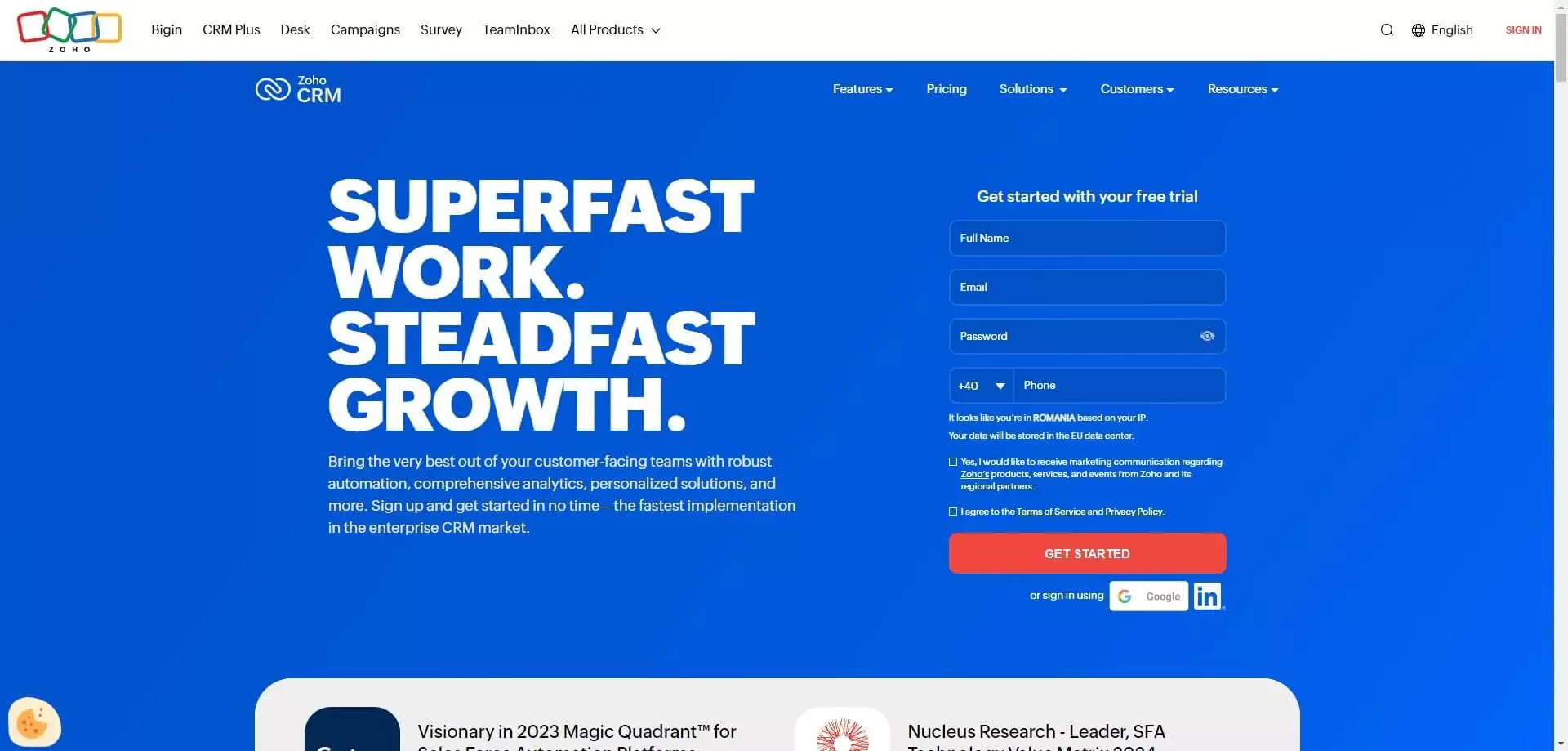

Zoho CRM is part of the larger Zoho platform, which they refer to as a business operating system. This includes an email service, project management software, helpdesk software, and many other useful apps.
Among HubSpot CRM alternatives, this is a great pick. The feature suite focuses on relationship building and automating virtually everything that can be automated, with various versions available, depending on the size of your business. Zoho also touts a thorough approach to privacy. So, no ad providers on the network and no third-party trackers.
Key features
- Automation for workflows, processes, campaigns, customer journeys, and beyond
- Advanced analytics tools that include custom reports and dashboards, plus the ability to measure operations live
- The option to go for personalized implementation, with custom mobile apps, functions, and applications
Pricing: All four Zoho CRM plans come with a 15-day free trial, then pricing starts at €14/user/mo, billed yearly.
Drawbacks: It’s important to check if Zoho CRM supports the specific tax policies from where your company is registered. Also, many users report that the transfer of contact lists can take some manual tweaking.
9. Pipedrive – best for sales automation
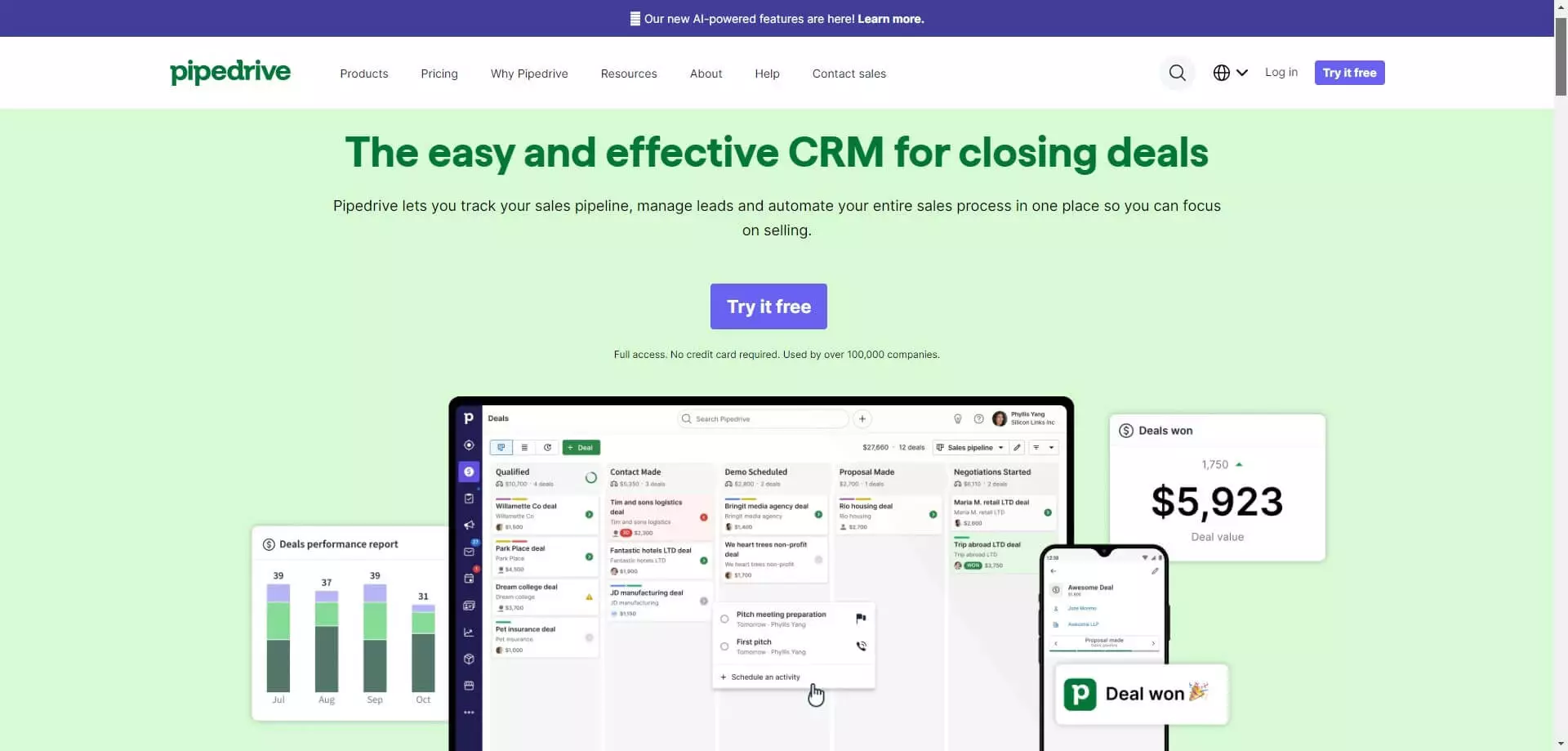

Pipedrive is a CRM platform that focuses on sales automation. It was created for small businesses that want to streamline sales and marketing processes, but it’s also a good fit for growing companies that need extra customization and reporting. Among other HubSpot alternatives, it sets itself apart with a product catalog and unlimited sales pipelines on every plan.
Key features
- A wealth of sales CRM tools that let you track deals, organize pipelines by sales team, and monitor recurring revenue from subscriptions
- A sales automation system with smart contact data that helps close deals, plus automated lead management
- Campaigns by Pipedrive, a separate email marketing solution that helps leverage CRM data to build and execute a solid email marketing strategy
Pricing: Pipedrive has five plans starting at €14/user/mo, billed annually. All five come with a 14-day free trial.
Drawbacks: Setting up is not super-intuitive and users report that integrations don’t always go over smoothly.
Choose the best marketing automation tools for your agency
The knack is to start from your business goals, daily activities, and the specific needs of your sales and marketing teams. Match up your processes to the feature bundles the above tools offer, but also keep an eye on scalability. How expensive do things get when you add more users or features?
Try Planable if you want to how easy it can be to handle marketing automation and content management from a single platform that’s built for collaboration. The free plan includes 50 posts and grants unlimited access to all the features and goodies.
Irina is a freelance senior copywriter & content writer with an advertising agency background. If she’s not rummaging for good synonyms, she’s probably watching a sitcom or listening to radio dramas with plucky amateur detectives. She loves collage, doing crosswords on paper and shazamming the birds outside her window.

